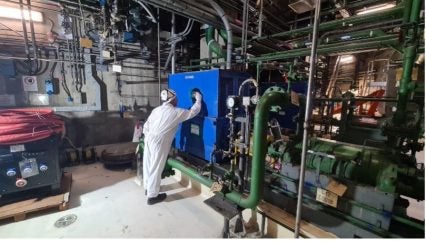
Italy’s Società Gestione Impianti Nucleari (Sogin) has begun dismantling the systems and components within the Caorso NPP reactor building. Caorso is a single-unit 860 MWe boiling water reactor plant, which began commercial operation in 1981. It was permanently shut down in 1990 and a decommissioning licence was granted in 2014. Italy was a leading nuclear power-producing country in the 1960s but chose to phase out all nuclear plants after a 1987 referendum following the Chernobyl disaster.
Sogin said the activities carried out so far have included the installation of the construction site electrical system and will continue with the installation of facilities for handling dismantled materials and the setting up of a plant for hot cutting to tackle the most complex components in terms of size and thickness.
Workers have already begun tracing the cutting points to dismantle the systems and components into pieces. This work is necessary, it said, to ensure that each element can be easily identified and grouped according to the plant system it comes from and its possible contamination level.
The first systems and components to be dismantled will be those at ground level to free up space for the passage of materials from other floors of the reactor building. At ground level Sogin has created a confined corridor, called the waste route, through which the cut components will be transferred to the turbine building to be decontaminated, cut and further reduced in volume to facilitate their subsequent management.
The dismantling project is divided into various sections, each of which includes a detailed dismantling plan. This planning ensures compliance with the safety criteria and requirements indicated by the National Inspectorate for Nuclear Safety & Radiation Protection (ISIN – L’Ispettorato nazionale per la sicurezza nucleare e la radioprotezione).
Some 3,400 tonnes of material will be dismantled, about 88% of which will be released after treatment and decontamination. The remaining 12% will be designated and managed as radioactive waste and stored on-site pending transfer to the national repository when it becomes available.
See also: Italy looks to end nuclear phase-out policy






